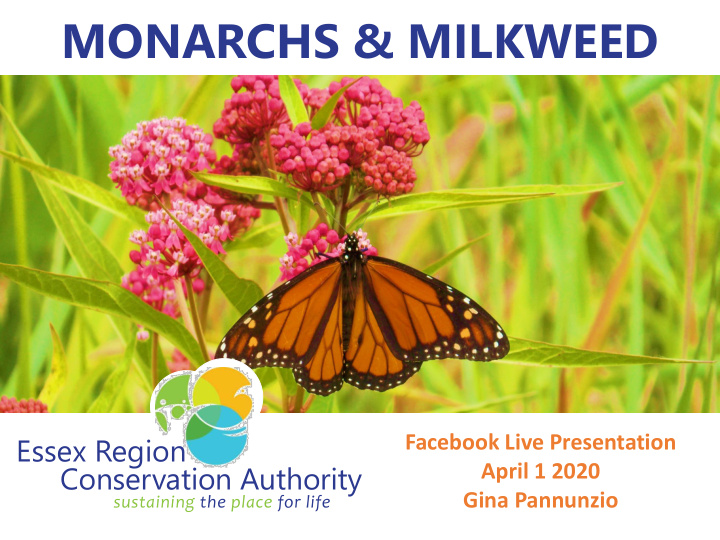



MONARCHS & MILKWEED Essex Region Facebook Live Presentation Conservation Authority April 1 2020 Gina Pannunzio sustaining the place for life
UNCOVERING 02 THE MYSTERY… Life Cycle Milkweed and Habitat Range across North America The Great Monarch Migration Status Threats Conservation More Information
MONARCH LIFE CYCLE Stage Time Egg 3 to 5 days Larva 10 to 14 days Pupa 10 to 14 days Adult 1 month or up to 9 months transformation from an immature form to an adult form in two or more life cycle stages.
MONARCH LIFE CYCLE Female monarchs lay on average 500 eggs over two to five weeks!
MONARCH LIFE CYCLE 4th Instar 3 rd Instar 1 st Instar 2 nd Instar 5th Instar Photo Credit: Karen Oberhauser
MONARCH LIFE CYCLE Photo Credit: Mary Holland
MONARCH LIFE CYCLE Photo Credit: Mary Holland
MONARCH MALE VS. FEMALE
MONARCH MALE VS. FEMALE
MONARCHS LOVE MILKWEED • Monarchs cannot survive without Milkweed (HUNGRY CATERPILLARS!) • Females lay their eggs on Milkweed • Monarchs develop a protection against bird predators from Milkweed (sap is toxic!)
Windbreak
MILKWEED 05 COMMUNITY • Milkweed is a host plant for LOTS of insects. • Attracted to the nectar, pollen, leaves, seeds, stems and roots of the plant. • Predatory insects hang around Milkweed.
MILKWEED COMMUNITY
06 Native gardens are more work (overall) than trees
Photo Photo credit: credit: JourneyNorth.org JourneyNorth.org
Photo Photo credit: credit: JourneyNorth.org JourneyNorth.org
Photo Photo credit: credit: JourneyNorth.org JourneyNorth.org
https://maps.journeynorth.org
https://maps.journeynorth.org
MONARCH STATUS The monarch is listed as Endangered by the Committee on the Status of Endangered Wildlife in Canada (COSEWIC) as of November 2016.
Threats to the Monarch Herbicide application • Illegal logging • Insecticide • Predation • Invasive species • Parasites and disease • Climate change (more severe storms • happening during migration times and warmer fall weather = confusing environmental cues to begin migration) Loss of spring and summer breeding • habitat in NA (loss of the most important plant to their lifecycle and other nectar plants used by adult butterflies)
CONSERVATION NORTH AMERICAN MONARCH CONSERVATION PLAN Canada, Mexico and the United States are working together to protect Monarch populations, migratory flyways and habitat. For additional information visit www.cec.org.
WHAT CAN YOU DO? 21 • Report a sighting • Volunteer with the local nature club ( Essex County Field Naturalists’ Club) • Be a good steward • Report illegal activity • Continue learning about the Monarch butterfly • Join local Facebook groups and follow pages
Groups and Pages on Facebook • Pelee Paradise Sanctuary Monarch Waystation #10275 • Monarch Butterfly Enthusiasts of Windsor and Essex County • Windsor Essex Nature Sightings
MORE RESOURCES Journey North Point Pelee National Park Monarch Watch (Monarch Waystation Program) Monarch Joint Venture Mission Monarch Monarch Journey WWF Canada Canadian Wildlife Federation
Gina Pannunzio Partnerships and Outreach Coordinator gpannunzio@erca.org and 519-776-5209 ext. 245
Recommend
More recommend